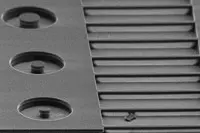 Researchers from Harvard, the University of California, Santa Barbara, and the University of Chicago have enhanced the fluorescent light emission of diamond nitrogen vacancy (NV) centres, a move said to have promise for quantum computing.
Researchers from Harvard, the University of California, Santa Barbara, and the University of Chicago have enhanced the fluorescent light emission of diamond nitrogen vacancy (NV) centres, a move said to have promise for quantum computing.  Researchers from Harvard, the University of California, Santa Barbara, and the University of Chicago have enhanced the fluorescent light emission of diamond nitrogen vacancy (NV) centres, a move said to have promise for quantum computing.
Researchers from Harvard, the University of California, Santa Barbara, and the University of Chicago have enhanced the fluorescent light emission of diamond nitrogen vacancy (NV) centres, a move said to have promise for quantum computing.
NV centres contain an unpaired electron that can store information using spin. The electron's spin state can be read by observing the intensity of particular frequencies of light emitted by the NV centre when illuminated by a laser.
To amplify the most important element of the signal researchers used a photonic cavity. "A photonic cavity that is properly matched to the NVs can substantially augment their capabilities," said Evelyn Hu, a researcher at Harvard. NV centres with signals enhanced by photonic cavities could act as qubits, the fundamental units of quantum information in a quantum computer.
The team said photonic cavities best enhance the signal of NV centres located in a 'hot spot', where the cavities' resonant fields are strongest, but making sure a defect's location matches up with this spot is tricky.
A first step was taken towards this goal by controlling the depth of the diamond defects using a technique called delta doping. "Integrating a plane of spins into these structures enables us to engineering the spin-photon interaction and exploit quantum effects for future technologies," said David Awschalom, a researcher at the University of Chicago. The technique confines the possible location of NV centres to a layer approximately 6nm thick sandwiched inside a diamond membrane approximately 200nm thick. Holes were then etched into the membrane to create the photonic cavities.
Using this method the researchers were able to increase the intensity of the light emitted by the NV centres by a factor of 30. The team believes the emission can be enhanced by controlling the position of the defects in the horizontal plane and is working on ways to achieve 3D control.
Author
Graham Pitcher
Source: www.newelectronics.co.uk